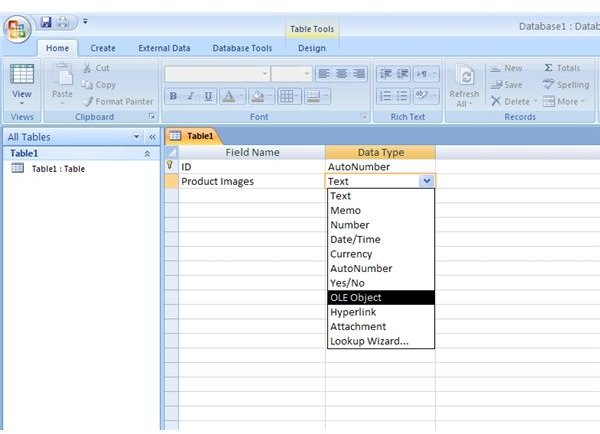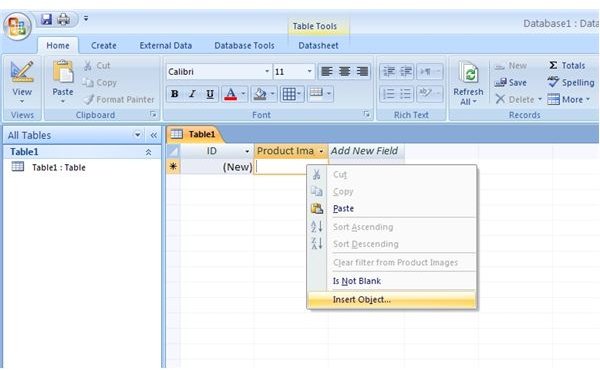How to Add Images, Pictures, or Photos to Access 2007
Access 2007 is Microsoft’s database program that is part of the Office 2007 suite of software. Among Word 2007, Excel 2007, and PowerPoint 2007, Access 2007 is an accessible and powerful desktop database application that is amazingly scalable and versatile.
Learning Access 2007 is quite simple; in fact, it is possible to gain great productivity with the database without having to know everything about it. In this document, you will learn how to add an image into a table using Microsoft’s Object Linking and Embedding (OLE) component document technology.
Adding an Image into an Access 2007 Table



Preparing to Add an Image into an Access 2007 Table
Before you can add an image to an Access 2007 table, you must first create a new database. Open Access 2007 and click on “New Blank Database” (see Figure 1). To the right of the screen, name your database and save to any location you want (the desktop is a good place for now). Click the “Create” button and you have a new blank Access 2007 database. Notice that Access 2007 starts you off with a table named “Table1.” For now, that table will do as a table into which to add an image.
On the Office 2007 Ribbon, change the view to “Design View” and type in a field name such as “Product Images” into Table 1 (see Figure 2). In the column labeled “Data Type” for the new “Product Images” field, use the drop down menu to change the “Product Images” field from text to “OLE Object” (see Figure 3).
OLE stands for Object Linking and Embedding and is Microsoft’s component document technology. Using OLE, you can link applications and files together dynamically. An object is defined as the data and application necessary to change data. With OLE, you can link and embed an object into a document that was created with a different application than the one into which you are embedding it.
It may sound complicated, but OLE is just a method created by Microsoft to link and embed objects and documents together in an application separate from the one used to create the object or document. By specifying the Data Type of the “Products Images” field as “OLE Object,” you are letting Access 2007 know that you will be placing an object or document into that particular field. Notice that the default Data Type is “Text.”
Adding an Image into an Access 2007 Table
Now that you have created a table, named a new field with the title “Product Images,” and specified that the field’s Data Type is OLE Object, you can now place your image into the table.
Using the Office 2007 Ribbon, go back to Datasheet View. Right click on any empty cell in the newly created “Product Images” field and click on “Insert Object” (see Figure 4). Note that this option would not have been available if the “Product Images” field still had a “Text” Data Type.
When you click on “Insert Object,” a new mini window opens asking if you want to create a new object or create a new object from a file. Before you continue, take a look at the list to the right when the “Create New” radio button is selected. You will see different object and document types here depending on the programs you have installed on your computer (or network). This list gives you an idea of just how versatile OLE is and the number of objects and documents that can be added to an Access 2007 Table.
To add an image you have already created, click the “Create from File” radio button and locate the image with the “Browse” button. When you find the image you want to add to the table, click “OK” and the cell will change to the word “Package” to indicate that an OLE object is present in that cell. Notice that the image itself is not shown in the cell. However, you have indeed added the image to the table. From here, you can use the image in any of your database applications or queries.
Warnings about Embedding Images into Access 2007
Although you can add images to Access 2007, you have to ask yourself whether adding the image is important enough to expand the size of the database with embedded images. If you will be using Access 2007 as the content backbone of a dynamic website, you are better off referencing the location of the image (such as a web server) in the database rather than embedding the image itself.
Databases can grow to enormous sizes when many images are embedded into them. This leads to slower queries, crashes, timeouts, and dissatisfied users, especially when the database is supplying content on a website. Use OLE with caution when adding images into a database.
Conclusion
Before you can add an image into an Access 2007 table, you must first specify that the field into which you will be embedding the object will contain an OLE Object. Using OLE, you can place any number of objects into Access 2007 tables including Office 2007 documents, images, video clips, and many other objects depending on the programs you have installed on your computer (or on your network). However, the ability to place images into an Access 2007 table comes with a caveat. The database will grow in size very quickly with each image added into a table. This is a bad idea if the database will provide content for a website or any place where space and time are important considerations.
